you’d be wrong. This male American Kestrel is the proof in the pudding.
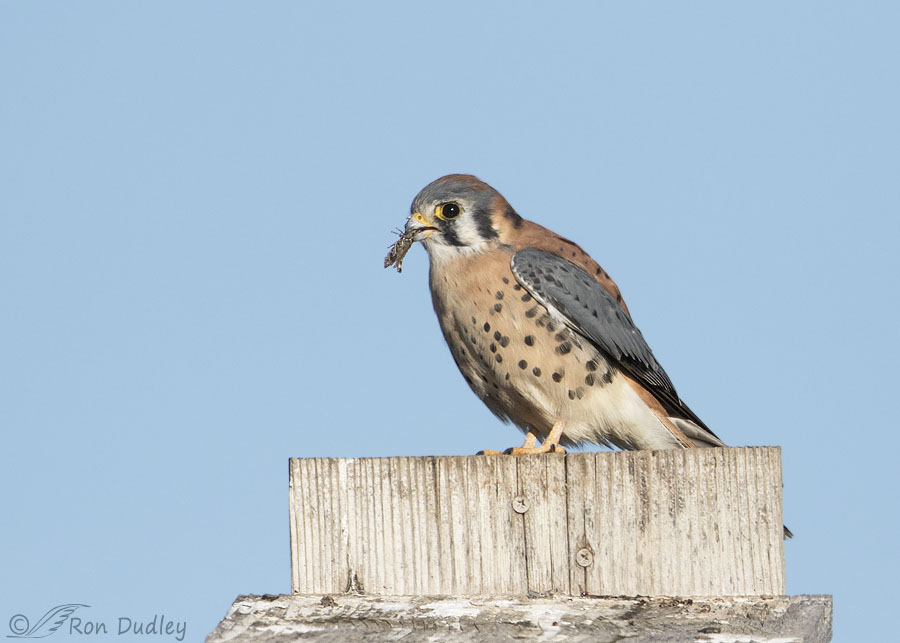
1/5000, f/6.3 ISO 500, Canon 7D Mark II, Canon EF 500mm f/4L IS II USM + EF 1.4 III Extender, not baited, set up or called in
In October of 2015 I found him on top of a kestrel nest box at Farmington Bay WMA as he enjoyed a breakfast of grasshopper. Nesting season was over so I was a little surprised when he finished his meal and then…
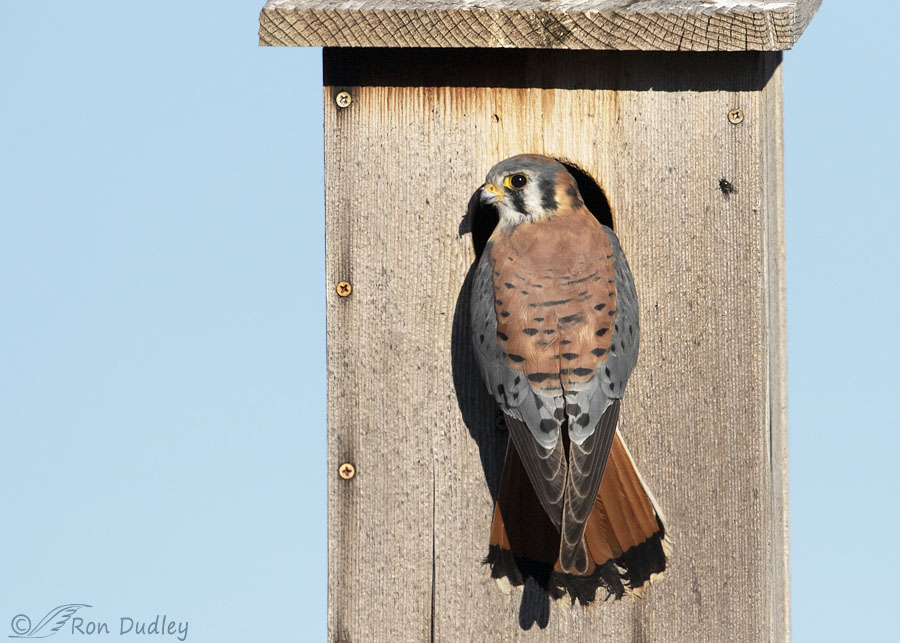
1/4000, f/7.1, ISO 500, Canon 7D Mark II, Canon EF 500mm f/4L IS II USM + EF 1.4 III Extender, not baited, set up or called in
flew down to enter the box. Kestrels occasionally roost in nest boxes any time of year so maybe his intention was simply to check it out. This shot was taken just before he entered the box.
Notice the house fly to the right of his head. That fly and others were buzzing around the box but he paid them absolutely no attention. After all, he wasn’t interested in them as food and they presented no threat to him (they obviously had no stinger). He absolutely knew this fly and others were there but he ignored them completely as he entered the box.
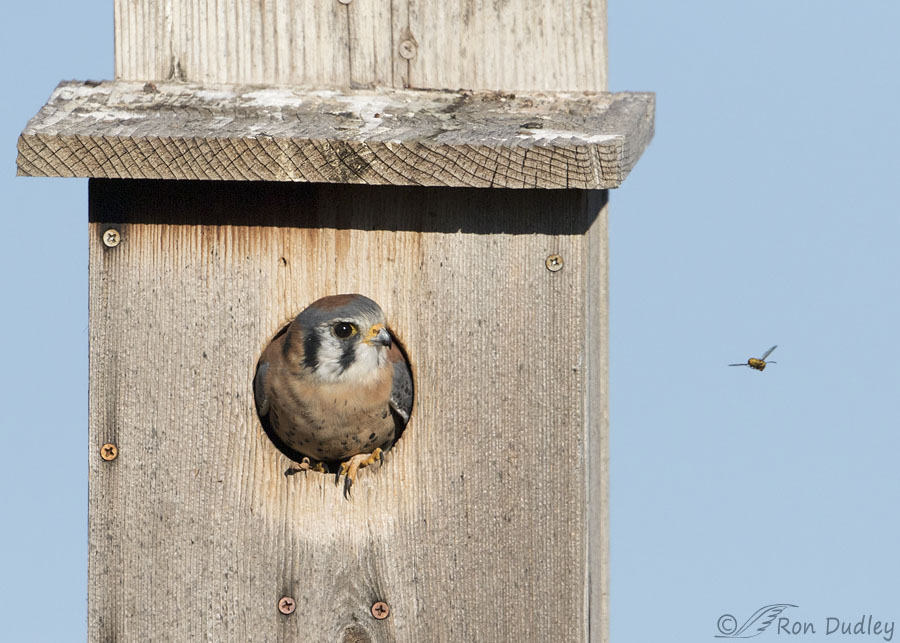
1/4000, f/7.1, ISO 500, Canon 7D Mark II, Canon EF 500mm f/4L IS II USM + EF 1.4 III Extender, not baited, set up or called in
Not so with another flying insect of the same size as he prepared to exit the box. This one wasn’t a house fly, instead it appeared to be some kind of stinging insect, possibly a small bee (more clearly seen in the last photo below).
His gaze never left that “bee” (or whatever it was) as it buzzed around the box.
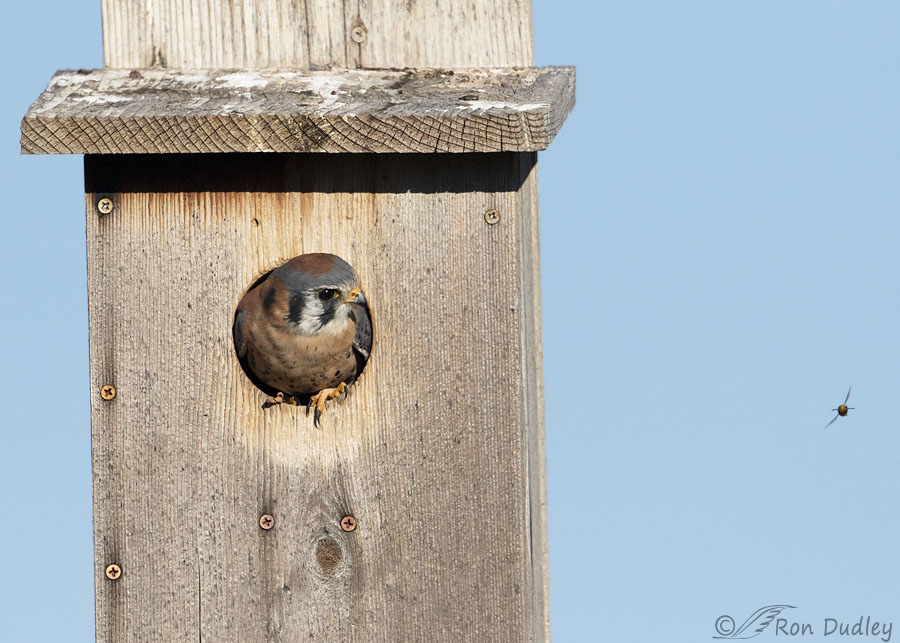
1/4000, f/7.1, ISO 500, Canon 7D Mark II, Canon EF 500mm f/4L IS II USM + EF 1.4 III Extender, not baited, set up or called in
He twisted his head to follow the little bee…
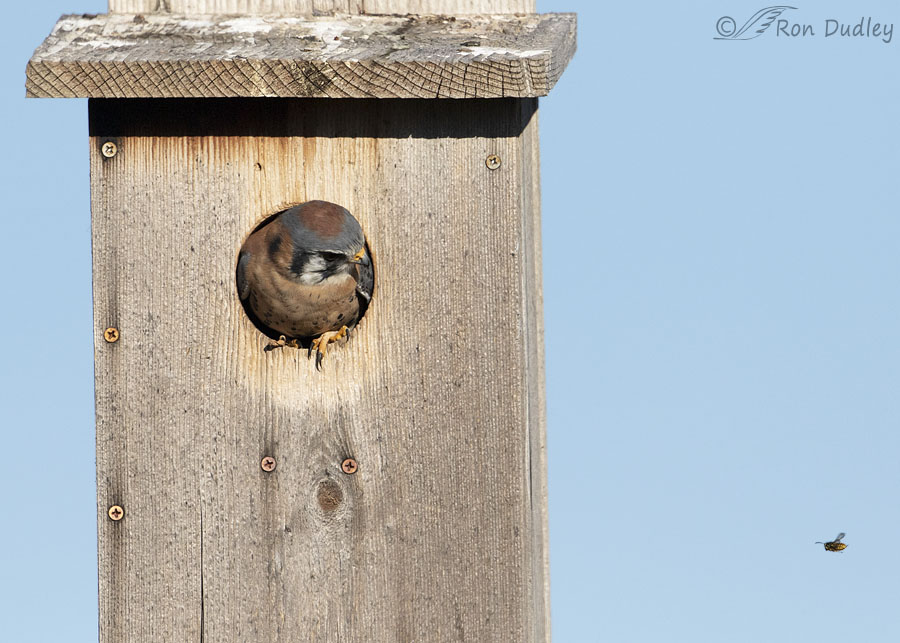
1/4000, f/7.1, ISO 500, Canon 7D Mark II, Canon EF 500mm f/4L IS II USM + EF 1.4 III Extender, not baited, set up or called in
wherever it went in three dimensions…
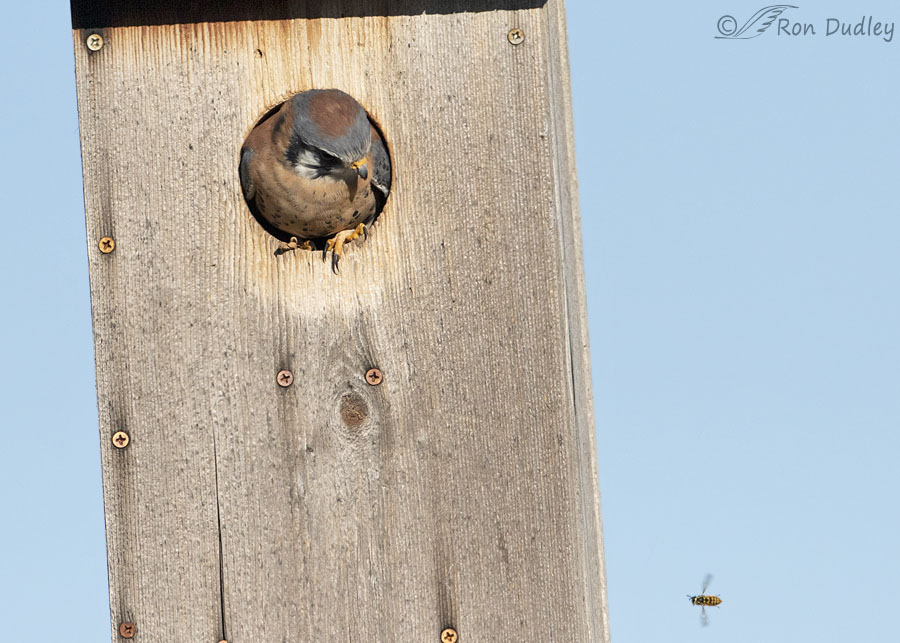
1/4000, f/7.1, ISO 500, Canon 7D Mark II, Canon EF 500mm f/4L IS II USM + EF 1.4 III Extender, not baited, set up or called in
until after this shot was taken when the bee harmlessly flew off. Apparently he wanted to make damn sure he wasn’t stung.
I’m convinced that the difference between how the kestrel reacted to the fly and how it reacted to the bee was because he recognized the latter as a potential stinging threat. I’ve seen similar reactions from various species of songbirds – very little escapes the attention of birds. The kestrel not only noticed the small flying insect, he distinguished between it and the harmless species. He noticed “the little things” I referred to in my title.
Which is more than I can say for yours truly who didn’t even notice that my camera was tilted when I took this series. I rotated the previous photos to level during processing but I couldn’t rotate this last shot because if I had it would have cropped out the bee.
Readers know I have an issue with keeping my camera level. If nothing else I’m consistent with my bad habits.
Ron
Notes:
- I’m no entomologist but I do like to get things right so I’m uncomfortable with calling the second insect a “bee” when I don’t really know what it is. If any of my readers know I’d appreciate an ID.
- I was just lucky to get four shots that included the bee. I didn’t even know it was there until I looked at the photos at home. The only reason I fired off the burst when I did was because I was trying to anticipate the kestrel’s takeoff (I failed).
- Proof “in” the pudding or proof “of” the pudding? I waffled on that one but apparently both are acceptable.


Agree that the wasp is a Yellow Jacket.
Thanks.
Until that wasp ( I agree with Martha with it most likely being a yellow jacket) came along he certainly had maintained close observation of you! He certainly would avoid that stinger. I have seen kestrels using nesting boxes at various times of the year and was curious about it since these were not nesting times. Really like that second photo…such colors they sport.
Yeah, he checked me out very carefully before he went into the box. He knew he’d be vulnerable in there since I watched him go in.
Of course they notice the little things. They have to. It is a survival technique. And, as others have said, if tilting my camera was the worst of my bad habits I would be chuffed.
EC, I’ll admit it. I had to look up “chuffed”. I figured it out by context but wanted to be sure. I never know what I’ll learn around here…
Fun series, Ron. It’s nice to see a dorsal view in the second shot as he checks you out over his shoulder (“Hey, a little privacy here, Mister!”). And I’d be happy if the worst of my bad habits was just tilting my camera!
Ha, I’d be happy if that were the case with me too!
Hello, Ron –
1. Cameras. Around here, you can rent cameras to try out. Got that around you?
2. The bee – is probably a wasp, and if you go here https://www.insectidentification.org/insects-by-type-and-region.asp?thisState=utah&thisType=Bee,%20Ant,%20Wasp%20and%20Similar you can probably identify it. Looks like a yellow jacket to me.
3. Proof of the pudding is short for “The proof of the pudding is in the eating.” https://en.wiktionary.org/wiki/the_proof_of_the_pudding_is_in_the_eating.
Enjoy your weekend.
Hi Martha,
1. Yes, I can rent the 1DXMark II and a few others from my camera dealer.
2. Thanks for that link. I’ll check it out and see if I can conclusively make the ID.
3. Yes, I’m aware of the original phrase. But there’s a “modern version” too and to me it seemed to fit better:
https://www.urbandictionary.com/define.php?term=the%20proof%20is%20in%20the%20pudding
Amazing behavioral series Ron, one of your best! Thanks for sharing!
Charlotte
Thanks very much, Charlotte.
Nice series showing this interesting behavior.This week I have been watching a kestrel catch dragonflies. When I lived in New Mexico we had a pair of kestrels raise a family and their chicks (falconlets?) which, after fledging, walked about along the road catching and eating grasshoppers in their beaks like chickens.
Ken, I often think they eat grasshoppers like ice cream cones when they hold them in one foot, raise them to their mouth, and then nibble on them.
Kestrels are EXQUISITE. Great series!
Thanks, Nicky.
I know a very good photographer who also notices the little things and turns them into very informative blogs (and highly entertaining ones to boot).
If that photographer happens to be me I appreciate the kind words, Lyle.
Ron, re your search for a new camera, I know you said you didn’t want to go mirrorless, but in light of your failed attempt to capture takeoff of this Kestrel, I am prompted to suggest an Olympus mirrorless camera. I am downsizing from my previous Nikon equipment and have decided to try the Olympus mirrorless system. It has a feature called ProCapture. Basically you focus on a stationary subject, like a bird you are hoping will take off; you press shutter button half way. The camera starts to capture frames. When the bird does take off you depress the shutter button completely and it continues to capture shots until you release. If you are not fast enough it doesn’t matter because you have captured frames from before you reacted and pushed the button. Of course, you can still miss the shot if you get tired of waiting for take off.
Thanks for the suggestion Justine but I’m pretty sure I’m not going mirrorless. I’ve checked into it carefully and that would likely be my best option if I was just starting out in bird photography but at this point I have too much invested in Canon lenses (that I love) to switch. I know I could use an adapter but there are too many disadvantages to going that route.
Fun! “Little things” ARE critical to them as far as food or not food, threat or not threat… Of course, I’m also pretty good at sorting that out too with “bugs” and snakes! Heavy, wet snow this morning with cold to follow……. WHEE!
Heavy, wet snow this morning with cold to follow……. WHEE! 
That’s right. As someone said on Facebook noticing the little things can be a matter of life and death.
Only rain here for now. May get snow tonight.
That’s a neat post Ron. Really nice photos and definitely gave me a chuckle watching that guy checking out the bee. We are hoping that this spring more Kestrels here will make use of the unused boxes we have out.
Thanks, Everett. We have more unused kestrel boxes around here than I like to see too. But groups like HawkWatch International sure put in the effort with building and monitoring those boxes, with pretty good success.
I’m just laughing because that’s what I do with any stinging bug too!
Yup, I saw myself too…